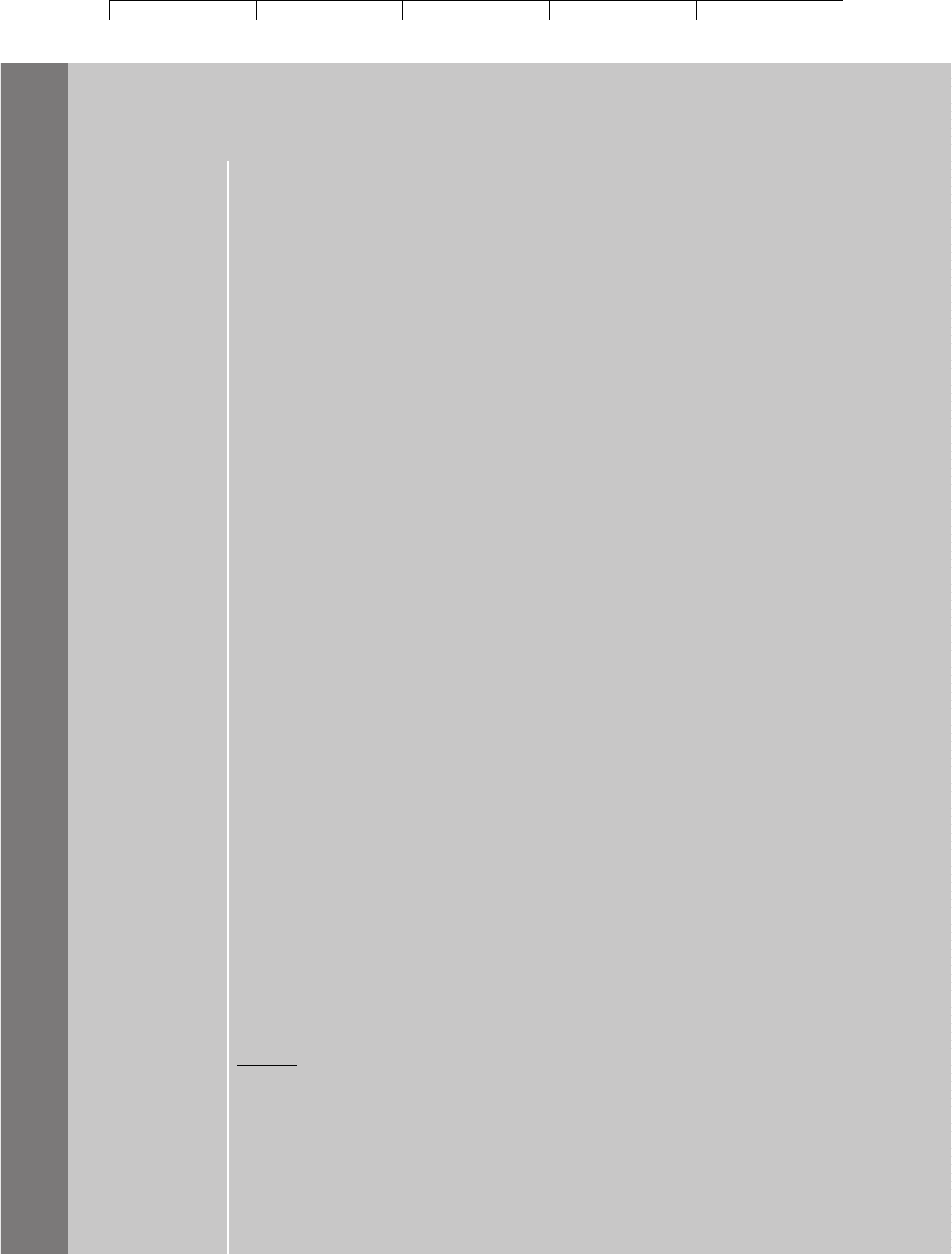Brealey, Myers. Principles of Corporate Finance. 7th edition
Подождите немного. Документ загружается.


Brealey−Meyers:
Principles of Corporate
Finance, Seventh Edition
IX. Financial Planning and
Short−Term Management
30. Short−Term Financial
Planning
© The McGraw−Hill
Companies, 2003
borrower is an established customer, remains creditworthy, and has a sound
business reason for making the change.
20
Rate of Interest Short-term bank loans are often made at a fixed rate of interest,
which is often quoted as a discount. For example, if the interest rate on a one-year
loan is stated as a discount of 5 percent, the borrower receives 100 ⫺ 5 ⫽ $95 and
undertakes to pay $100 at the end of the year. The return on such a loan is not 5 per-
cent, but 5/95 ⫽ .0526, or 5.26 percent.
For longer-term bank loans the interest rate is usually linked to the general level
of interest rates. The most common benchmarks are the London Interbank Offered
Rate (LIBOR), the federal funds rate,
21
or the bank’s prime rate. Thus, if the rate is
set at “1 percent over LIBOR,” the borrower may pay 5 percent in the first three
months when LIBOR is 4 percent, 6 percent in the next three months when LIBOR
is 5 percent, and so on.
22
Syndicated Loans Some bank loans are far too large for a single bank. In these
cases the loan may be arranged by one or more lead banks and then parceled out
among a syndicate of banks. For example, when Vodafone Airtouch needed to bor-
row $24 billion (a25 billion) to help finance its bid for the German telephone com-
pany, Mannesmann, it engaged 11 banks from around the world to arrange a large
syndicate of banks that would lend the cash.
Loan Sales Large banks often have more demand for loans than they can satisfy;
for smaller banks it is the other way around. Banks with an excess demand for
loans may solve the problem by selling a portion of their existing loans to other in-
stitutions. Loan sales have mushroomed in recent years. In 1991 they totalled only
$8 million; by 2000 they had reached $129 billion.
23
These loan sales generally take one of two forms: assignments or participations. In
the former case a portion of the loan is transferred with the agreement of the bor-
rower. In the second case the lead bank maintains its relationship with its borrow-
ers but agrees to pay over to the buyer a portion of the cash flows that it receives.
Participations often involve a single loan, but sometimes they can be huge deals
involving hundreds of loans. Because these deals change a collection of nonmar-
ketable bank loans into marketable securities, they are known as securitizations. For
example, in 1996 the British bank, Natwest, securitized about one-sixth of its loan
book. Natwest first put together a $5 billion package of about 200 loans to major
firms in 17 different countries. It then sold notes, each of which promised to pay a
proportion of the cash that it received from the package of loans. Because the notes
provided the chance to share in a diversified portfolio of high-quality loans, they
proved very popular with investors from around the world.
Security If a bank is concerned about a firm’s credit risk, it will ask the firm to
provide security for the loan. Since the bank is lending on a short-term basis, this
868 PART IX
Financial Planning and Short-Term Management
20
Term loans typically allow the borrower to repay early, but in many cases the loan agreement speci-
fies that the firm must pay a penalty for early repayment.
21
The federal funds rate is the rate at which banks lend excess reserves to each other.
22
In addition to paying interest, the borrower may be obliged to maintain a minimum interest-free deposit
(compensating balance) with the bank. Compensating balances for bank loans are now relatively rare.
23
Loan Pricing Corporation (www.loanpricing.com).

Brealey−Meyers:
Principles of Corporate
Finance, Seventh Edition
IX. Financial Planning and
Short−Term Management
30. Short−Term Financial
Planning
© The McGraw−Hill
Companies, 2003
security usually consists of liquid assets such as receivables, inventories, or securi-
ties. Sometimes the bank will accept a floating charge against these assets.
24
This
gives it a general claim if the firm defaults, but it does not specify the assets in de-
tail, and it sets few restrictions on what the company can do with the assets.
More commonly, banks will require specific collateral. For example, suppose
that there is a significant delay between the time that you ship your goods and
when your customers pay you. If you need the money up front, you can borrow
using these receivables as collateral. First, you must send the bank a copy of each
invoice and provide it with a claim against the money that you receive from your
customers. The bank will then lend up to 80 percent of the value of the receivables.
Each day, as you make more sales, your collateral increases and you can borrow
more money. Each day also some customers pay their bills. This money is placed
in a special collateral account under the bank’s control and is periodically used to
reduce the size of the loan. Therefore, as the firm’s business fluctuates, so does the
amount of the collateral and the size of the loan.
25
You can also use inventories as security for a loan. For example, if your goods
are stored in a warehouse, you need to arrange for an independent warehouse
company to provide the bank with a receipt showing that the goods are held on the
bank’s behalf. When the loan is repaid, the bank returns the warehouse receipt and
you are free to remove the goods.
26
Banks are naturally choosy about the collateral that they will accept. They want to
make sure that they can identify and sell the collateral if you default. For example,
they may be happy to lend against a warehouse full of a standard nonperishable
commodity, but they would turn up their nose at a warehouse of ripe Camemberts.
Banks also need to ensure that the collateral is kept safe and the borrower
doesn’t sell the assets and run off with the money. This is what happened in
the great salad oil swindle. Fifty-one banks and companies made loans of nearly
$200 million to the Allied Crude Vegetable Oil Refining Corporation. In return
the company agreed to provide security in the form of storage tanks full of valu-
able salad oil. Unfortunately, the cursory inspections of the tanks failed to notice
that they simply contained seawater and sludge. When the fraud was discov-
ered, the president of Allied went to jail and the 51 lenders were left out in the
cold, looking for their $200 million.
27
Lenders have been more careful since then,
but Finance in the News shows that even old scams can still work.
Commercial Paper
Banks borrow money from one group of firms or individuals and relend the money
to another group. They make their profit by charging the borrower a higher rate of
interest than they offer the lender.
CHAPTER 30
Short-Term Financial Planning 869
24
Floating charges are common in other countries.
25
In Chapter 32 we will describe how firms sometimes raise money by selling their receivables to a fac-
tor. The factor is responsible for collecting the debt and suffers any losses if the customers don’t pay.
When you pledge your receivables as collateral for a loan, you remain responsible for collecting the debt
and you suffer if a customer is delinquent.
26
It is not always practicable to keep inventory in a warehouse. For example, automobile dealers need
to display their cars in a showroom. One solution is to enter into a floor-planning arrangement in which
the finance company buys the cars and the dealer holds them in trust. When the cars are sold, the pro-
ceeds are used to redeem the cars from the finance company.
27
See N.C. Miller, The Great Salad Oil Swindle, London, Gollancz, 1966.

Brealey−Meyers:
Principles of Corporate
Finance, Seventh Edition
IX. Financial Planning and
Short−Term Management
30. Short−Term Financial
Planning
© The McGraw−Hill
Companies, 2003
Sometimes it is convenient to have a bank in the middle. It saves the lenders the
trouble of looking for borrowers and assessing their creditworthiness, and it saves
borrowers the trouble of looking for lenders. Depositors do not care whom the
bank lends to: They need only satisfy themselves that the bank as a whole is safe.
There are also occasions on which it is not worth paying an intermediary to
perform these functions. Large well-known companies can bypass the banking
system by issuing their own short-term unsecured notes. These notes are known
as commercial paper (CP). Financial institutions, such as bank holding compa-
nies and finance companies,
28
also issue commercial paper, sometimes in very
large quantities. For example, GE Capital Corporation has nearly $70 billion of
commercial paper in issue. The major issuers of commercial paper have set up
their own marketing departments and sell their paper directly to investors, often
870
FINANCE IN THE NEWS
THE HAZARDS OF SECURED BANK LENDING
The National Safety Council of Australia’s Victoria
Division had been a sleepy outfit until John
Friedrich took over. Under its new management,
NSC members trained like commandos and were
prepared to go anywhere and do anything. They
saved people from drowning, they fought fires,
found lost bushwalkers and went down mines.
Their lavish equipment included 22 helicopters, 8
aircraft and a mini-submarine. Soon the NSC began
selling its services internationally.
Unfortunately the NSC’s paramilitary outfit cost
millions of dollars to run—far more than it earned
in revenue. Friedrich bridged the gap by borrowing
$A236 million of debt. The banks were happy to
lend because the NSC’s debt appeared well se-
cured. At one point the company showed $A107
million of receivables (that is money owed by its
customers), which it pledged as security for bank
loans. Later checks revealed that many of these
customers did not owe the NSC a cent. In other
cases banks took comfort in the fact that their
loans were secured by containers of valuable res-
cue gear. There were more than 100 containers
stacked around the NSC’s main base. Only a hand-
ful contained any equipment, but these were the
ones that the bankers saw when they came to
check that their loans were safe. Sometimes a sus-
picious banker would ask to inspect a particular
container. Friedrich would then explain that it was
away on exercise, fly the banker across the country
in a light plane and point to a container well out in
the bush. The container would of course be empty,
but the banker had no way to know that.
Six years after Friedrich was appointed CEO, his
massive fraud was uncovered. But a few days before
a warrant could be issued, Friedrich disappeared. Al-
though he was eventually caught and arrested, he
shot himself before he could come to trial. Investiga-
tions revealed that Friedrich was operating under an
assumed name, having fled from his native Germany,
where he was wanted by the police. Many rumors con-
tinued to circulate about Friedrich. He was variously
alleged to have been a plant of the CIA and the KGB
and the NSC was said to have been behind an at-
tempted counter-coup in Fiji. For the banks there was
only one hard truth. Their loans to the NSC, which had
appeared so well secured, would never be repaid.
Source: Adapted from Chapter 7 of T. Sykes, The Bold Riders, Allen
& Unwin, St. Leonards, NSW, Australia, 1994.
28
A bank holding company is a firm that owns both a bank and nonbanking subsidiaries.

Brealey−Meyers:
Principles of Corporate
Finance, Seventh Edition
IX. Financial Planning and
Short−Term Management
30. Short−Term Financial
Planning
© The McGraw−Hill
Companies, 2003
CHAPTER 30 Short-Term Financial Planning 871
using the Web to do so. Smaller companies sell through dealers who receive a fee
for marketing the issue.
Commercial paper in the United States has a maximum maturity of nine
months, though most paper is for 60 days or less. Buyers of commercial paper gen-
erally hold it to maturity, but the company or dealer that sells the paper is usually
prepared to repurchase it earlier.
The majority of commercial paper is issued by high-grade, nationally known
companies.
29
Companies generally support their issue of commercial paper by ar-
ranging a backup line of credit with a bank, which guarantees that they can find
the money to repay the paper.
30
The risk of default is, therefore, small.
Commercial paper is very popular with major companies. By cutting out the in-
termediary, they are able to borrow at rates that may be 1 to 1.5 percent below the
prime rate charged by banks. Even after allowing for a dealer’s commission and
the cost of any backup line of credit, this is still a substantial savings. Banks have
felt the competition from commercial paper and have been prepared to reduce
their rates to blue-chip customers. As a result, “prime rate” doesn’t mean what it
used to. It once meant the rate banks charged their most creditworthy customers.
Now the prime customers often pay less than the prime rate.
Medium-Term Notes
New issues of securities do not need to be registered with the SEC as long as they ma-
ture within 270 days. So by limiting the maturity of commercial paper issues, compa-
nies can avoid the delays and expense of registration. However, large blue-chip com-
panies also make regular issues of unsecured medium-term notes (MTNs).
You can think of MTNs as a hybrid between corporate bonds and commercial
paper. Like bonds, they are relatively long-term instruments; their maturity is
never less than 270 days and may be as long as 30 years.
31
On the other hand, like
commercial paper, MTNs are not underwritten but are sold on a regular basis ei-
ther through dealers or, occasionally, direct to investors. Borrowers, such as finance
companies, that are always needing cash, welcome the flexibility of MTNs. For ex-
ample, a company may tell its dealer the amount of money that it needs to raise
that week, the range of maturities that it can offer, and the maximum interest that
it is prepared to pay. It is then up to the dealers to find the buyers.
29
Moody’s and Standard and Poor’s publish quality ratings for commercial paper. For example, Moody’s
provides three ratings, from P-1 (denoting Prime 1, the highest-grade paper) to P-3. Most investors are
reluctant to buy low-rated paper. For example, money-market funds are largely limited to holding P-1 paper.
30
Banks often reserve the right to cancel this line of credit if there is a material adverse change in the
company’s condition. However, lower-rated companies may back their paper with an irrevocable line
of credit.
31
The Walt Disney Company has even used its MTN shelf registration to issue a 100-year bond.
SUMMARY
Short-term financial planning is concerned with the management of the firm’s
short-term, or current, assets and liabilities. The most important current assets are
cash, marketable securities, inventory, and accounts receivable. The most impor-
tant current liabilities are short-term loans and accounts payable. The difference
between current assets and current liabilities is called (net) working capital.
Visit us at www.mhhe.com/bm7e

Brealey−Meyers:
Principles of Corporate
Finance, Seventh Edition
IX. Financial Planning and
Short−Term Management
30. Short−Term Financial
Planning
© The McGraw−Hill
Companies, 2003
872 PART IX Financial Planning and Short-Term Management
Visit us at www.mhhe.com/bm7e
Current assets and liabilities are turned over much more rapidly than the other
items on the balance sheet. Short-term financing and investment decisions are
more quickly and easily reversed than long-term decisions. Consequently, the fi-
nancial manager does not need to look so far into the future when making them.
The nature of the firm’s short-term financial planning problem is determined by
the amount of long-term capital it raises. A firm that issues large amounts of long-
term debt or common stock, or which retains a large part of its earnings, may find
that it has permanent excess cash. In such cases there is never any problem paying
bills, and short-term financial planning consists of managing the firm’s portfolio of
marketable securities. We think that firms with permanent cash surpluses ought to
return the excess cash to their stockholders.
Other firms raise relatively little long-term capital and end up as permanent
short-term debtors. Most firms attempt to find a golden mean by financing all
fixed assets and part of current assets with equity and long-term debt. Such
firms may invest cash surpluses during part of the year and borrow during the
rest of the year.
The starting point for short-term financial planning is an understanding of
sources and uses of cash.
32
Firms forecast their net cash requirements by fore-
casting collections on accounts receivable, adding other cash inflows, and sub-
tracting all cash outlays. If the forecasted cash balance is insufficient to cover
day-to-day operations and to provide a buffer against contingencies, the com-
pany will need to find additional finance. The search for the best short-term fi-
nancial plan inevitably proceeds by trial and error. The financial manager must
explore the consequences of different assumptions about cash requirements, in-
terest rates, sources of finance, and so on. Firms are increasingly using comput-
erized financial models to help in this process. The models range from simple
spreadsheet programs that merely help with the arithmetic to linear program-
ming models that help to find the best financial plan.
If you foresee a large and permanent cash deficiency, the financial plan may in-
volve raising long-term finance. If the shortage is temporary, you may be able to fi-
nance it by not paying your bills for a while or you can choose from a variety of
short- and medium-term loans.
Often firms arrange a revolving line of credit with a bank that allows them to bor-
row up to an agreed amount whenever they need financing. This is usually intended
to tide the firm over a temporary shortage of cash and is therefore repaid in only a
few months. However, banks also make term loans that sometimes extend for five
years or more. In addition to borrowing from their domestic banks, companies may
borrow dollars (or any other currency) from overseas banks or the foreign branches
of U.S. banks. These international bank loans often involve huge sums of money and
in this case they may be syndicated among a group of major banks.
Many bank loans are unsecured, but less-creditworthy borrowers may be
asked to provide security. Sometimes this consists of a floating charge on receiv-
ables and inventories, but usually you will be asked to pledge specific assets.
When you borrow against receivables, the bank is informed of all sales of goods
32
We pointed out in Section 30.3 that sources and uses of funds are often analyzed rather than sources
and uses of cash. Anything that contributes to working capital is called a source of funds; anything that
diminishes working capital is called a use of funds. Sources and uses of funds statements are relatively
simple because many sources and uses of cash are buried in changes in working capital. However, in
forecasting, the emphasis is on cash flow. You pay bills with cash, not working capital.

Brealey−Meyers:
Principles of Corporate
Finance, Seventh Edition
IX. Financial Planning and
Short−Term Management
30. Short−Term Financial
Planning
© The McGraw−Hill
Companies, 2003
CHAPTER 30 Short-Term Financial Planning 873
and the resulting receivables are pledged to the bank. As the customers pay their
bills, the money is paid into a special collateral account under the bank’s control.
Similarly, when you borrow against stocks of raw materials, the bank may insist
that the goods are under the control of an independent warehouse company. As
long as the bank holds the warehouse receipt for these goods, they cannot be re-
leased without the bank’s permission.
The interest rate on very short-term bank loans is generally fixed for the life of
the loan, but in other cases the rate floats with the general level of short-term in-
terest rates. For example, it might be set at 1 percent over LIBOR (the London In-
terbank Offered Rate).
Of course, the interest rate that the bank charges must be sufficient to cover not
only the opportunity cost of capital for the loan but also the costs of running the
loan department. As a result, large regular borrowers have found it cheaper to by-
pass the banking system and issue their own short-term unsecured debt. This is
called commercial paper. Longer-term loans that are marketed on a regular basis are
known as medium-term notes.
FURTHER
READING
Here are some general textbooks on working-capital management:
G. W. Gallinger and P. B. Healey: Liquidity Analysis and Management, 2nd. ed., Addison-
Wesley Publishing Company, Inc., Reading, MA, 1991.
N. C. Hill and W. L. Sartoris: Short-Term Financial Management: Text and Cases, 3rd. ed.,
Prentice-Hall, Inc., Englewood Cliffs, NJ, 1995.
K. V. Smith and G. W. Gallinger: Readings on Short-Term Financial Management, 3rd ed., West
Publishing Company, New York, 1988.
J. H. Vander Weide and S. F. Maier: Managing Corporate Liquidity: An Introduction to Working
Capital Management, John Wiley & Sons, Inc., New York, 1985.
F. C. Scherr: Modern Working Capital Management: Text and Cases, Prentice-Hall, Inc., Engle-
wood Cliffs, NJ, 1989.
Pogue and Bussard present a linear programming model for short-term financial planning:
G. A. Pogue and R. N. Bussard: “A Linear Programming Model for Short-Term Financial
Planning under Uncertainty,” Sloan Management Review, 13:69–99 (Spring 1972).
QUIZ
1. Fill in the blanks in the following statements:
a. A firm has a cash surplus when its ______ exceeds its ______. The surplus is
normally invested in ______.
b. In developing the short-term financial plan, the financial manager starts with a
budget for the next year. This budget shows the ______ generated or absorbed by
the firm’s operations and also the minimum ______ needed to support these
operations. The financial manager may also wish to invest in ______ as a reserve for
unexpected cash requirements.
c. Short-term financing plans are developed by ______ and ______, often aided by
computerized ______.
2. Listed below are six transactions that Dynamic Mattress might make. Indicate how each
transaction would affect (a) cash and (b) working capital.
Visit us at www.mhhe.com/bm7e

Brealey−Meyers:
Principles of Corporate
Finance, Seventh Edition
IX. Financial Planning and
Short−Term Management
30. Short−Term Financial
Planning
© The McGraw−Hill
Companies, 2003
874 PART IX Financial Planning and Short-Term Management
Visit us at www.mhhe.com/bm7e
The transactions are
i. Pay out $2 million cash dividend.
ii. Receive $2,500 from a customer who pays a bill resulting from a previous sale.
iii. Pay $5,000 previously owed to one of its suppliers.
iv. Borrow $1 million long term and invest the proceeds in inventory.
v. Borrow $1 million short term and invest the proceeds in inventory.
vi. Sell $5 million of marketable securities for cash.
3. State how each of the following events would affect the firm’s balance sheet. State
whether each change is a source or use of cash.
a. An automobile manufacturer increases production in response to a forecasted
increase in demand. Unfortunately, the demand does not increase.
b. Competition forces the firm to give customers more time to pay for their
purchases.
c. Inflation increases the value of raw material inventories by 20 percent.
d. The firm sells a parcel of land for $100,000. The land was purchased five years
earlier for $200,000.
e. The firm repurchases its own common stock.
f. The firm doubles its quarterly dividend.
g. The firm issues $1 million of long-term debt and uses the proceeds to repay a
short-term bank loan.
4. Here is a forecast of sales by National Bromide for the first four months of 2003 (figures
in $ thousands):
Month 1 Month 2 Month 3 Month 4
Cash sales 15 24 18 14
Sales on credit 100 120 90 70
On the average 50 percent of credit sales are paid for in the current month, 30 percent
are paid in the next month, and the remainder are paid in the month after that. What is
the expected cash inflow from operations in months 3 and 4?
5. Dynamic Futon forecasts the following purchases from suppliers:
Jan. Feb. Mar. Apr. May Jun.
Value of goods ($ millions) 32 28 25 22 20 20
a. Forty percent of goods are supplied cash on delivery. The remainder are paid with
an average delay of one month. If Dynamic Futon starts the year with payables of
$22 million, what is the forecasted level of payables for each month?
b. Suppose that from the start of the year the company stretches payables by paying
40 percent after one month and 20 percent after two months. (The remainder
continue to be paid cash on delivery.) Recalculate payables for each month
assuming that there are no cash penalties for late payment.
6. Each of the following events affects one or more tables in the chapter. Show the effects
of each event by adjusting the tables listed in parentheses:
a. Dynamic repays only $2 million of short-term debt in 2001. (Tables 30.2, 30.4–30.6)
b. Dynamic issues an additional $10 million of long-term debt in 2001 and invests $12
million in a new warehouse. (Tables 30.2, 30.4–30.6)
c. In 2001 Dynamic reduces the quantity of stuffing in each mattress. Customers
don’t notice, but operating costs fall by 10 percent. (Tables 30.2–30.6)

Brealey−Meyers:
Principles of Corporate
Finance, Seventh Edition
IX. Financial Planning and
Short−Term Management
30. Short−Term Financial
Planning
© The McGraw−Hill
Companies, 2003
CHAPTER 30 Short-Term Financial Planning 875
d. Starting in the third quarter of 2002, Dynamic employs new staff members who
will prove very effective in persuading customers to pay more promptly. As a
result, 90 percent of sales are paid for immediately, and 10 percent are paid in the
following quarter. (Tables 30.7 and 30.8)
e. Starting in the first quarter of 2002, Dynamic cuts wages by $4 million a quarter.
(Table 30.8)
f. In the second quarter of 2002 a disused warehouse mysteriously catches fire.
Dynamic receives a $10 million check from the insurance company. (Table 30.8)
g. Dynamic’s treasurer decides he can scrape by on a $2 million operating cash
balance. (Table 30.8)
7. True or false?
a. Most commercial bank loans are made under commitment.
b. A line of credit provides the lender with a put option.
c. Bank term loans typically have a maturity of several years.
d. If the interest rate on a one-year bank loan is stated as a discount of 10 percent, the
actual yield on the loan is less than 10 percent.
e. The interest rate on term loans is usually linked to LIBOR, the federal funds rate,
or the bank’s prime rate.
8. Complete the passage below by selecting the most appropriate terms from the follow-
ing list: floating charge, commercial paper, warehouse receipt, collateral, commitment fee, line
of credit, medium-term notes.
Companies with fluctuating capital needs often arrange a ______ with their bank. This
is relatively expensive because companies need to pay a ______ on any unused
amount.
Secured short-term loans are sometimes covered by a ______ on all receivables
and inventory. Generally, however, the borrower pledges specific assets as ______. For
example, if goods are stored in a warehouse, an independent warehouse company
may issue a ______ to the lender. The goods can then only be released with the lender’s
consent.
Banks are not the only source of short-term debt. Many large companies issue their
own unsecured debt directly to investors, often on a regular basis. If the maturity is less
than nine months, this debt is generally known as ______. Companies also make regu-
lar issues of longer term debt to investors. These are called ______.
PRACTICE
QUESTIONS
1. Table 30.10 lists data from the budget of Ritewell Publishers. Half the company sales are
for cash on the nail; the other half are paid for with a one-month delay. The company
pays all its credit purchases with a one-month delay. Credit purchases in January were
$30, and total sales in January were $180. Complete the cash budget in Table 30.11.
February March April
Total sales 200 220 180
Purchases of materials
For cash 70 80 60
For credit 40 30 40
Other expenses 30 30 30
Taxes, interest, and dividends 10 10 10
Capital investment 100 0 0
TABLE 30.10
Selected budget data for Ritewell
Publishers.
Visit us at www.mhhe.com/bm7e

Brealey−Meyers:
Principles of Corporate
Finance, Seventh Edition
IX. Financial Planning and
Short−Term Management
30. Short−Term Financial
Planning
© The McGraw−Hill
Companies, 2003
876 PART IX Financial Planning and Short-Term Management
Visit us at www.mhhe.com/bm7e
2. If a firm pays its bills with a 30-day delay, what fraction of its purchases will be paid in
the current quarter? In the following quarter? What if the delay is 60 days?
3. Which items in Table 30.9 would be affected by the following events?
a. There is a rise in interest rates.
b. Suppliers demand interest for late payment.
c. Dynamic receives an unexpected bill in the third quarter from the Internal Revenue
Service for underpayment of taxes in previous years.
4. Table 30.12 shows Dynamic Mattress’s year-end 1999 balance sheet, and Table 30.13
shows its income statement for 2000. Work out statements of sources and uses of cash
and sources and uses of funds for 2000.
Current assets: Current liabilities:
Cash 4 Bank loans 4
Marketable securities 2 Accounts payable 15
Inventory 20 Total current liabilities 19
Accounts receivable 22
Total current assets 48 Long-term debt 5
Net worth (equity and
retained earnings) 60
Fixed assets:
Gross investment 50
Less depreciation ⫺14
Net fixed assets 36 Total liabilities
Total assets 84 and net worth 84
TABLE 30.12
Year-end balance sheet for 1999
(figures in $ millions).
February March April
Sources of cash:
Collections on cash sales
Collections on accounts receivable — — —
Total sources of cash
Uses of cash:
Payments of accounts payable
Cash purchases of materials
Other expenses
Capital expenditures
Taxes, interest, and dividends
Total uses of cash — — —
Net cash inflow
Cash at start of period 100
⫹ Net cash inflow
⫽ Cash at end of period
⫹ Minimum operating cash balance 100 100 100
⫽ Cumulative short-term financing required
TABLE 30.11
Cash budget for
Ritewell Publishers.

Brealey−Meyers:
Principles of Corporate
Finance, Seventh Edition
IX. Financial Planning and
Short−Term Management
30. Short−Term Financial
Planning
© The McGraw−Hill
Companies, 2003
CHAPTER 30 Short-Term Financial Planning 877
Visit us at www.mhhe.com/bm7e
5. Work out a short-term financing plan for Dynamic Mattress Company, assuming the
limit on the line of credit is raised from $38 to $50 million. Otherwise keep to the as-
sumptions used in developing Table 30.9.
6. Dynamic Mattress decides to lease its new mattress-stuffing machines rather than buy
them. As a result, capital expenditure in the first quarter is reduced by $30 million, but
the company must make lease payments of $1.5 million for each of the four quarters.
Assume that the lease has no effect on tax payments until after the fourth quarter. Con-
struct two tables like Tables 30.8 and 30.9 showing Dynamic’s cumulative financing re-
quirement and a new financing plan.
7. You need to borrow $10 million for 90 days. You have the following alternatives:
a. Issue high-grade commercial paper, with a back-up line of credit costing .3 percent
a year.
b. Borrow from First Cookham Bank at an interest rate of .25 percent over LIBOR.
c. Borrow from the Test Bank at prime.
Given the rates currently prevailing in the market (see, for example, The Wall Street
Journal), which alternative would you choose?
8. Suppose that you are a banker responsible for approving corporate loans. Nine firms
are seeking secured loans. They offer the following assets as collateral:
a. Firm A, a heating oil distributor, offers a tanker load of fuel in transit from the
Middle East.
b. Firm B, a wine wholesaler, offers 1,000 cases of Beaujolais Nouveau, located in a
warehouse.
c. Firm C, a stationer, offers an account receivable for office supplies sold to the City
of New York.
d. Firm D, a bookstore, offers its entire inventory of 15,000 used books.
e. Firm E, a wholesale grocer, offers a boxcar full of bananas.
f. Firm F, an appliance dealer, offers its inventory of electric typewriters.
g. Firm G, a jeweler, offers 100 ounces of gold.
h. Firm H, a government securities dealer, offers its portfolio of Treasury bills.
i. Firm I, a boat builder, offers a half-completed luxury yacht. The yacht will take
four months more to complete.
Which of these assets are most likely to be good collateral? Which are likely to be bad
collateral? Explain.
9. Any of the assets mentioned in the preceding question could be acceptable collateral un-
der certain circumstances if appropriate safeguards were taken. What circumstances?
What safeguards? Explain.
10. Interest rates on bank loans exceed rates on commercial paper. Why don’t all firms is-
sue commercial paper rather than borrow from banks?
Sales 300
Operating costs ⫺285
15
Depreciation ⫺2
13
Interest ⫺1
Pretax income 12
Tax at 50% ⫺6
Net income 6
TABLE 30.13
Income statement for 2000 (figures in $ millions).
Note: Dividend ⫽ $1 million; retained earnings ⫽ $5 million.
